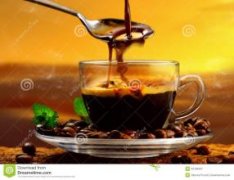The planting market price of high-quality coffee beans in Kahayang Ganzhuang Garden, Indonesia is simple.

Taste characteristics: Manning coffee is considered to be the richest coffee in the world, a light earthy aroma, and some people describe it as the aroma of herbs. The palate is rich and solid, with a pleasant sour taste. The smell is mellow, the acidity is moderate, the sweetness is rich and very intriguing, it is suitable for deep baking and exudes a strong aroma. Mantenin has a strong taste, with a strong mellow and rich and lively sense of movement, neither astringent nor sour, mellow and bitter can be fully revealed. The appearance of Mantenin coffee beans is arguably the ugliest, but coffee fans say that the ugliest Sumatran coffee beans are, the better, mellow and slippery tawahu coffee tastes. It refers to washed, semi-washed or sun-dried beans (less) at an altitude of 800-1600 meters above sea level near Tawahu, the northernmost region of Sumatra. This famous Raminita estate in Costa Rica teaches semi-washing technology, and the well-known Dutch coffee group mainly produces Gayou landscape wash beans, Manning coffee, which is produced in Sumatra, Indonesia, Asia. Also known as "Sumatran Coffee" grows in high-quality coffee beans in the highlands and mountains at an altitude of 750 to 1500 meters above sea level. The main producing areas are Java, Sulawesi and Sumatra, 90% of which are Robusta species. Among them, the "Mantelin" produced in Sumatra is the most famous. The best of the exquisite traditional Arabica coffee produced in northern Sumatra of Sumatra is sold as Lindong Lintong and Manning Mandheling. To be exact, Lindong Lintong refers to coffee growing in a small area in the southwest of Lake Toba in Lindong District. The small coffee growing area is scattered on a high and wavy clay plateau full of fern covers. Lintong Lindong Coffee is grown without shade, does not use chemicals, and is almost entirely owned by small private owners. Mandheling Manning is a broader term, including Lintong Lindong Coffee and Diari [capital Sidikalang] under similar conditions, the northern growing area of Lake Toba.
Main coffee producing area
Java, the oldest producing area, continues its reputation from the glory days of Indonesian coffee in the 18th century. Java coffee is still reminiscent of high-quality delicacy, when the most famous blend is Java coffee with Yemeni mocha. In addition, Java also has a very famous old coffee Aged coffee, or monsoon coffee Monsooned coffee.
Sumatra, the most legendary producing area, well-known coffee logos include Mandheling Mantenin, Lintong Lintong and Gayo Mountain Gayusan.
Sulawesi Island, famous coffee includes Delaga Toraja.
In addition, Bali, Flores and Timor are also important producing areas.
Coffee planting mode
In the Dutch colonial era, coffee was mainly grown in large estates. After World War II, it experienced the process of nationalization and the movement of independence. Today, about 90% of the coffee produced in Indonesia is produced by small farmers.
Coffee variety
At first, Indonesian coffee was Arabica, and the Arabica manor was destroyed by a leaf rust disaster at the end of the 18th century. at first, the Dutch tried to grow Liberian seeds, and later, they began to plant Robsta seeds on a large scale.
At present, Arabica species account for about 10-15% of the coffee produced in Indonesia, and the rest is Robusta. Although Liberika species are produced, they are basically not included in the coffee trade.
Coffee harvest
There are usually two harvest seasons in Indonesia, the main harvest season (main crop) occurs from September to October, and the second harvest season (fly crop) occurs from May to June.
Arabica will be picked by hand, and workers who pick by hand will enjoy a minimum wage, on the basis of which there will be performance pay.
Brief introduction of Indonesian Coffee Indonesian Coffee (1)
Coffee treatment
Coffee from Java is traditionally washed.
Sumatra and Sulawesi are famous for their "wet planing" wet-hulled with Indonesian characteristics, known locally as Giling Basah.
The drying methods in coffee processing vary according to the situation: high-priced bed drying in the awning, balcony drying, roadside drying and other methods are all used.
Coffee flavor
Although the flavor varies from region to region, Indonesian coffee is usually mentioned, and the excellent full body is most often mentioned.
It has two famous names, Sumatra DP first Class and Collection Sumatra Mantenin. Sumatra Mantenin DP has a long aftertaste, with a hillside fragrance, which is unique to the earthy taste of the primeval forest. In fact, Manning's mellow, is a very masculine feeling. High-quality first-class manning coffee is very sour, just like the slight acidity of flowers and fruits. In addition to the mellow taste of Indonesian coffee, there is also a bittersweet taste, which is popular with people who like to drink concentrated roasted coffee. Sumatran manning coffee is called "classic" because it is stored in the cellar for three years before export. But the collection coffee is not old coffee, but slightly pale coffee through special treatment, this kind of coffee is more full-bodied, the acidity will decrease, but the mellowness will increase, the finish will be longer, and will bring a strong spicy flavor, sometimes sour, sometimes walnut, sometimes chocolate. Before Blue Mountain Coffee was discovered, Manning was regarded as the best coffee. )
Roasting and production: Manning coffee is suitable for deep roasting in order to give full play to his rich taste. Suggestions on production: siphon pot, mocha pot, Italian coffee maker.
History:
(coffee cultivation in Indonesia began at the end of the 17th century and was transplanted from India by the Dutch East India Company to Jakarta, Java, for Arabica Typica, which soon spread to Sumatra in the northwest of Java and Sulawesi in the northeast. Tippika was withered by a massive rust outbreak in Java in the 1880s, and the Dutch changed to the disease-resistant Robsta. To this day, Robusta is still the main source of Indonesian coffee, accounting for 90% of Indonesian coffee. it is grown all over Java and Bali. The elegant Arabica is mainly distributed in the high-altitude areas of northern Sumatra, Sulawesi and Java, accounting for only about 10% of Indonesia's coffee production. However, Indonesian coffee, such as Mantenin, Golden Manning, Jinding Mantenin, Tawahu, Gayou Mountain, Axie, Sulawesi, aged Mantenin and Java Old Brown, have made Indonesian coffee famous in the boutique coffee world for decades. In 1999, he worked with UCC, the largest coffee distributor in Japan.
Important Notice :
前街咖啡 FrontStreet Coffee has moved to new addredd:
FrontStreet Coffee Address: 315,Donghua East Road,GuangZhou
Tel:020 38364473
- Prev

A brief introduction to the Origin, Development, History and Culture of Fine Coffee beans in the traditional Ganzhuang Garden in Kahayang, Indonesia
The following are the more well-known cafes in Indonesia: Indonesia PTJavArabica: general Manager of the Bakery Company, speaking of the opening process, he said: CaswellsCoffee was established in 2001, and the time is close to that of Starbucks in Indonesia. In addition to six points of sale, it is also famous for providing coffee roasters to five-star hotels, restaurants and coffee shops, as well as holding coffee cups for staff.
- Next

Fruit sweetness obvious Indonesia Kahayangan estate fine coffee beans cultivation geographical location
It can be said that Sumatra organic mantinin coffee beans are very mysterious and wonderful, taste harmonious, bloom more diverse expressions and rich posture, belong to rare taste, its charming sugar charred sweet fragrance and long return to sweet, very dumping. Country: Indonesia Region: Sumatra/Aceh / GAYO Mountain Estate: GAYO Organic
Related
- Does Rose Summer choose Blue, Green or Red? Detailed explanation of Rose Summer Coffee plots and Classification in Panamanian Jade Manor
- What is the difference between the origin, producing area, processing plant, cooperative and manor of coffee beans?
- How fine does the espresso powder fit? how to grind the espresso?
- Sca coffee roasting degree color card coffee roasting degree 8 roasting color values what do you mean?
- The practice of lattes: how to make lattes at home
- Introduction to Indonesian Fine Coffee beans-- Java Coffee producing area of Indonesian Arabica Coffee
- How much will the flavor of light and medium roasted rose summer be expressed? What baking level is rose summer suitable for?
- Introduction to the characteristics of washing, sun-drying or wet-planing coffee commonly used in Mantenin, Indonesia
- Price characteristics of Arabica Coffee Bean Starbucks introduction to Manning Coffee Bean Taste producing area Variety Manor
- What is the authentic Yega flavor? What are the flavor characteristics of the really excellent Yejasuffi coffee beans?

